
Using AIDR to Collect and Analyze Tweets from Chile Earthquake
Wish you had a better way to make sense of Twitter during disasters than this?

Using AIDR to Collect and Analyze Tweets from Chile Earthquake
Wish you had a better way to make sense of Twitter during disasters than this?

Communities: the institutions of the 21st century? An interview with Rachel Botsman
Since her influential book about how collaborative consumption is changing the way we live, Rachel Botsman has been a leading actor in the collaborative economy and stimulated important debates about its future. OuiShare Fest Co-chair Francesca spoke to her about her vision of the collaborative economy movement, her current work and what she will bring to OuiShare Fest this May.
A lot has happened since your book “What’s Mine is Yours”. Did you imagine the collaborative economy would look the way it does today? Where do you see the movement going now?
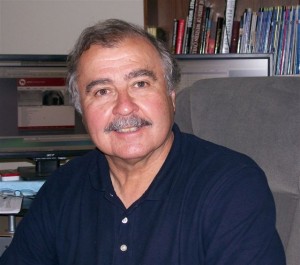
Open Data Collection with Ushahidi
March 28, 2014
The crowdsourced data collection platform Ushahidi, now assisting activists worldwide, was first created to facilitate public accountability and social activism during crises in its home nation, Kenya. Not surprisingly, Ushahidi is also the name of the non-profit behind the open-source project. Open-Steps.org interviewed the organization’s director of data projects, Chris Albon, about the platform. The article prefaces the dialogue with a brief explanation:
“In a nutshell, it allows citizens to make reports in a collaborative way, creating crowdsourced interactive maps. With a very intelligent approach, Ushahidi gives citizens the possibility to use the web, their smartphones and even SMS to gather data, which makes this technology accessible almost everywhere and for everyone. Originally created in Kenya to serve as an instrument for social activism and public accountability in crisis situations, the software has proven to be a great companion worldwide in bringing advocacy campaigns to a successful end. The team behind Ushahidi has not only created a world-changing technology but also they share it with others since it is released as Open Source.”
Albon tells us that the core Ushahidi platform is now being used in 159 countries and has been translated into 35 languages, and explains it is being used by groups from small, election-monitoring non-profits to global organizations tracking disaster relief efforts. Journalists also make use of the platform. Albon notes that his group helped build iHub in Nairobi, an “innovation hub” and community workspace designed to facilitate collaboration and community growth. See the article for more on this and Ushahidi’s other projects, Crowdmap, Swiftriver, Ping, and BRCK. The interview wraps up with something to look forward to: the next generation of the Ushahidi core platform, v3, is on its way.
Cynthia Murrell, March 28, 2014
Sponsored by ArnoldIT.com, developer of Augmentext

People Are Sharing in the Collaborative Economy for Convenience and Price
Below Graphic: Partnered with Vision Critical, Crowd Companies (the association I started for big brands in the collaborative economy) surveyed over 90,000 people to find out why they share goods, services, space, transportation, and money.
A dissection of the largest study in the Collaborative Economy
Over the coming months, we’ll be dissecting some of the key findings from the largest study ever done on the Collaborative Economy, sharing both factual data and insights beyond market observations. When people first think of the sharing economy, a subset of the greater Collaborative Economy, they think of technology-laden hipsters in communes. What we found was quite the opposite – that this sharing behavior is common place behavior across many scenarios. We discovered that people often share for reasons that made pragmatic sense for themselves – not community altruism. If you want to view the entire report (over 28k already have), you may download it by clicking here.
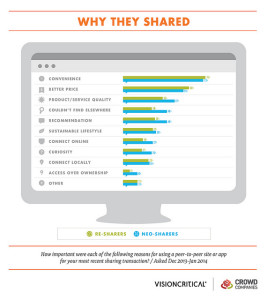

Launching a Search and Rescue Challenge for Drone / UAV Pilots
My colleague Timothy Reuter (of AidDroids fame) kindly invited me to co-organize the Drone/UAV Search and Rescue Challenge for the DC Drone User Group. The challenge will take place on May 17th near Marshall in Virginia. The rules for the competition are based on the highly successful Search/Rescue challenge organized by my new colleague Chad with the North Texas Drone User Group. We’ll pretend that a person has gone missing by scattering (over a wide area) various clues such pieces of clothing and personal affects. Competitors will use their UAVs to collect imagery of the area and will have 45 minutes after flying to analyze the imagery for clues.
. . . . . . .
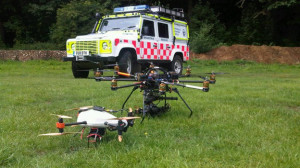
I want to try something new with this challenge. While previous competitions have focused exclusively on the use of drones/UAVs for the “Search” component of the challenge, I want to introduce the option of also engaging in the “Rescue” part. How? If UAVs identify a missing person, then why not provide that person with immediate assistance while waiting for the Search and Rescue team to arrive on site? The UAV could drop a small and light-weight first aid kit, or small water bottle, or even a small walkie talkie. Enter my new colleague Euan Ramsay who has been working on a UAV payloader solution for Search and Rescue; see the video demo below. Euan, who is based in Switzerland, has very kindly offered to share several payloader units for our UAV challenge. So I’ll be meeting up with him next month to take the units back to DC for the competition.

Results of the Crowdsourced Search for Malaysia Flight 370
EXTRACT
If these digital efforts continue and Flight 370 has indeed been hijacked, then this will certainly be the first time that crowdsourced satellite imagery analysis is used to find a hijacked aircraft. The latest satellite imagery uploaded by Tomnod is no longer focused on bodies of water but rather land. The blue strips below (left) is the area that the new satellite imagery covers.
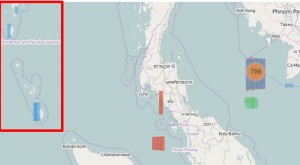
Some important questions will need to be addressed if this operation is indeed extended. What if the hijackers make contact and order the cessation of all offline and online Search & Rescue operations? Would volunteers be considered “digital combatants,” potentially embroiled in political conflict in which the lives of 227 hostages are at stake?
Analyzing Tweets on Malaysia Flight #MH370
My QCRI colleague Dr. Imran is using our AIDR platform (Artificial Intelligence for Disaster Response) to collect & analyze tweets related to Malaysia Flight 370 that went missing several days ago. He has collected well over 850,000 English-language tweets since March 11th; using the following keywords/hashtags: Malaysia Airlines flight, #MH370m #PrayForMH370 and #MalaysiaAirlines.
Continue reading “Patrick Meier: Crowd-Sourcing and Malaysian Airlines (2)”

“To find a form that accommodates the mess, that is the task of the artist now.”
– Samuel Beckett
Paracity is a biourban organism that is growing on the principles of Open Form: individual design-build actions generating spontaneous communicative reactions on the surrounding built human environment and this organic constructivist dialog leading into self-organized community structures, development and knowledge building.
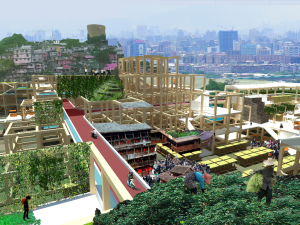
The growing organism the Paracity is based on a three dimensional wooden primary structure, organic grid with spatial modules of 6 x 6 x 6 metres (6 meters is approximately 18 feet)constructed out of CLT cross-laminated timber sticks. This simple structure can be modified and grown by the community members working as teams or by an assigned Paracity constructor.
Paracity’s self-sustainable biourban growth is backed up by off-the-grid environmental technology solutions providing methods for water purification, energy production, organic waste treatment, waste water purification and sludge recycling. These modular plug-in components can be adjusted according to the growth of the Paracity and moreover, the whole Paracity is designed not only to treat and circulate its own material streams, but to start leaching waste from its host city becoming a positive urban parasite following the similar kind of symbiosis as in-between slums and the surrounding city. In a sense Paracity is a high-tech slum, which can start tuning the industrial city towards an ecologically more sustainable direction.